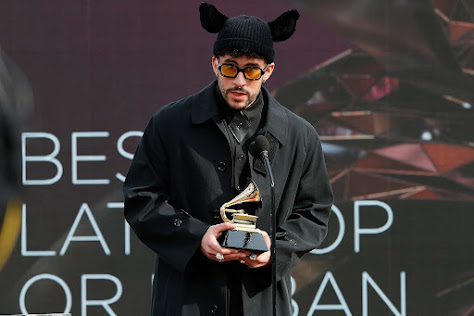Another year of innovation for Latin pop. A Puerto Rican superstar led the pack, but other Spanish-languages thrived, too.
Latin Music - a purposely loose category that encompasses countless national, regional and local styles - has always pointed toward joyful innovation.
Across the Americas, historical forces including colonialism, slavery, indigenous perseverance, and cultural and individual resourcefulness forged music that is richly, creatively hybridized. Latin music has long proved that the fusions broaden connections.
In 1938, the New Orleans pianist and composer Jelly Roll Morton, speaking about the origins of jazz, told Alan Lomax, ''If you can't manage to put tinges of Spanish in your tunes, you will never be able to get the right seasoning, I call it, for jazz.''
Pop in 2022 was unequivocally dominated by the Puerto Rican superstar Bad Bunny. Songs from his latest album, ''Un Verano Sin Ti'' [''A Summer Without You''], were streamed billions of times, keeping it at No. 1 on the Billboard album chart for much of the year.
His tours and other live performances grossed $435 million, according to Billboard Boxscore. Even so, his triumph was anything but a surprise. Every one of the six albums that the artist, born Benito Antonio Ocasio, has released since 2018 has been a billion-streamer.
Yet he has stuck to lyrics in Spanish. Unlike prior waves of Latin pop hitmakers who have reached a wider U.S. market, Bad Bunny is very clearly not bothering to court an English-Language crossover. The world is listening anyway.
Bad Bunny's voice - a rich baritone groan that can sound both supremely confident and perpetually unsatisfied - has become one of the most recognizable sounds of the 21st century, at home in every collaboration and any idiom he chooses, from reggaeton to punk-pop.
He has built a persona as a hard-partying, raunchy, fashion forward Casanova who also speaks out about Puerto Rico's pride and frustrations. And the commercial success of ''Un Verano Sin Ti'' was so undeniable that it became the first release performed entirely in Spanish to receive a Grammy nomination for album of the year.
That's a very belated milestone. It's also just a hint of how much diverse, brilliant Spanish-language pop appeared in 2022 : from forward looking pop contenders like Rosalia and Rauw Alejandro; from introspective yet sonically ambitious songwriters like Carla Morrison and iLe; and from experimental composers like Lucrecia Dalt.
Drawing freely and idiosyncratically on tradition, all of them have found ways to recast multigenerational lore into music for the here and now.
What Morton called the ''Spanish tinge'' actually came from Afro-Cuban rhythms like the habanera. Rhythms, dynamics, melodic contours, vocal inflections and other ideas from Latin music has repeatedly catalyzed mainstream musical evolution : in jazz, rock 'n' roll, psychedelia, disco, electronic dance music and hip-hop.
Current pop has found an international common denominator in the reggaeton beat that emerged decades ago in Panama and Puerto Rico. Now it sounds like an syncopated pulse.
In the era of streaming and the Internet, Latin music has reconfigured the meaning of regional styles. A particular beat or a standard instrumental lineup - a cumbia by a mariachi band, or a bachata with electric guitar and bongos - still points clearly to a singular place of origin, to Mexico or the Dominican Republic.
But musicians aren't confining themselves to homeland styles or shunning outsiders. With everything available for listening or sampling or layering, far more boundary-hopping takes place. Bad Bunny's album, for instance, focuses on reggaeton but also dips into bachata, cumbia and meregengue.
In the best new Latin pop, genre hopping and genre slicing are clearly a matter of musical curiosity and shared intentions, not crossover calculation.
The World Students Society thanks author Jon Pareles.

.png)


0 comments:
Post a Comment
Grace A Comment!